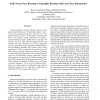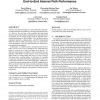ICPADS
2005
IEEE
14 years 5 months ago
2005
IEEE
We show that universal routing can be achieved with low overhead in distributed networks. The validity of our results rests on a new network called the fat-stack. We show that fro...
ICNP
2005
IEEE
14 years 5 months ago
2005
IEEE
Routing in mobile ad hoc networks remains as a challenging problem given the limited wireless bandwidth, users’ mobility and potentially large scale. Recently, there has been a ...
ICNP
2005
IEEE
14 years 5 months ago
2005
IEEE
In this paper, we introduce Z-Ring, a fast prefix routing protocol for peer-to-peer overlay networks. Z-Ring incorporates cost-efficient membership protocol to achieve fast routin...
ICNP
2005
IEEE
14 years 5 months ago
2005
IEEE
Existing geographic routing algorithms depend on the planarization of the network connectivity graph for correctness, and the planarization process gives rise to a welldefined no...
DATE
2005
IEEE
14 years 5 months ago
2005
IEEE
As the scale of electronic devices shrinks, “electronic textiles” (e-textiles) will make possible a wide variety of novel applications which are currently unfeasible. Due to t...
AINA
2005
IEEE
14 years 5 months ago
2005
IEEE
The network lifetime for wireless sensor network plays an important role to survivability. Thus, we indicate the importance of routing protocol to network lifetime, and model the ...
SIGCOMM
2006
ACM
14 years 5 months ago
2006
ACM
Extensive measurement studies have shown that end-to-end Internet path performance degradation is correlated with routing dynamics. However, the root cause of the correlation betw...
SIGCOMM
2006
ACM
14 years 5 months ago
2006
ACM
The Internet consists of thousands of independent domains with different, and sometimes competing, business interests. However, the current interdomain routing protocol (BGP) limi...
SIGCOMM
2006
ACM
14 years 5 months ago
2006
ACM
Traditional studies of routing problems often assumed strict preferences on paths, by eliminating ambiguity in path comparisons, or imposing a priori deterministic tie-breaking. S...
SIGCOMM
2006
ACM
14 years 5 months ago
2006
ACM
It is accepted wisdom that the current Internet architecture conflates network locations and host identities, but there is no agreement on how a future architecture should distin...


